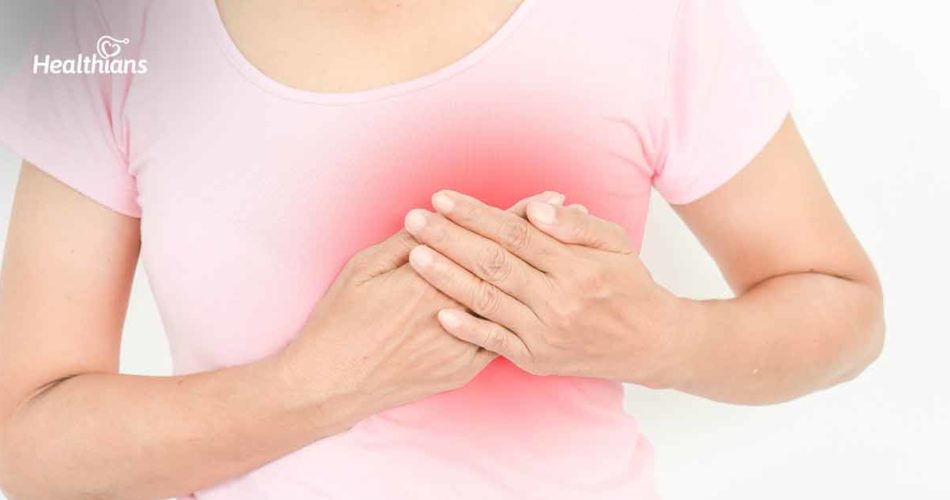Contributed by: Healthians Team
Introduction
Lumpy breast tissue affects more than half of women at some point in their lives.
Most of these lumps are benign (non-cancerous), and many of these benign lumps, have cystic nature.
This disorder called fibrocystic breasts—once called fibrocystic breast disease—is common for women of all ages, especially between 30 and 50 years.
The exact cause of fibrocystic breast changes isn’t known, but experts suspect that it happens in response to the reproductive hormones — estrogen and progesterone — which affect the breast tissue.
Fluctuating hormonal levels often causes significant pain and discomfort in the breast. Although the pain is cyclic, it impairs every day and sexual life in 30% to 40% of women suffering from the condition.
Symptoms of fibrocystic breasts
Women with fibrocystic breasts are thought to have two to eight times greater risk of developing breast cancer.
Even those whose lumps remain benign often experience extreme discomfort in the breast.
The most common symptoms that may be felt in both breasts are:
- Lumps or masses in the breast
- Dense texture in the breast
- Generalized breast pain or tenderness
- Breast swelling or soreness
- Heaviness in the breast
Beyond the above symptoms, women with fibrocystic breasts may also experience discomfort under the arms and discharge from the nipple—these are all benign.
However, if the discharge is bloody or clear, you should consult a doctor or gynaecologist immediately.
Fibrocystic breast changes treatment and food remedies
The effectiveness of dietary interventions to reduce fibrocystic breast changes is continually undergoing investigations. Some studies report that the condition may improve by dietary changes.
Although research hasn’t found proof of a link between dietary factors and fibrocystic breast changes, if you have this condition, you might adopt the below dietary alterations to see if it helps.
Some of the remedies mentioned below are supported by good clinical evidence, while others are not.
Minimize caffeine
Although caffeine is not a direct cause of fibrocystic changes in the breasts, many experts believe that methylxanthines in caffeine can worsen your symptoms.
Large amounts of caffeine, a stimulant found in coffee and many teas and colas, can cause changes in hormone levels that may affect the formation of breast cysts or cause breast pain.
Research on limiting caffeine consumption as a treatment for breast pain has yielded mixed results and clinical studies have not shown consistent findings.
Nevertheless, some women have reported that limiting caffeine consumption improves breast pain.
Lower saturated fat
Reducing the amount of saturated fat you consume has been associated with less severe symptoms of fibrocystic breasts.
Studies establishing a correlation between the two have indicated that increased intake of saturated fat (in red meat and dairy products, including cheese, cream, and full-fat yoghurt) can worsen fibrocystic breast disease.
Limit sodium intake
As with caffeine, there is not a conclusive link between salt intake and breast cysts.
However, there are reports demonstrating that cutting out or dramatically lowering the salt levels in your diet may help reduce the size of your cysts.
Salt induces the body to retain fluids. If the body holds on to extra fluid, the breast tissue will too because cysts of fibrocystic breasts are primarily fluid-filled sacs.
Increase soy intake
Increased consumption of soy foods is significantly associated with a lower incidence of fibrocystic breasts.
This protective effect is due to daidzein and genistein, two compounds found in soybeans that have the ability to prevent fibrocystic breast changes.
Further research is needed to determine the precise relationship between the two.
Eat flaxseeds
Some research shows that the flax plant is the best plant for a decrease of pain (mastalgia) in fibrocystic breasts.
Flaxseed, also known as linseed, is classified as omega 3 fatty acids that help reduce inflammation.
High in fibre, these little seeds contain lignans that have shown promising results in safeguarding breast health.
Women suffering from fibrocystic breast disease should consider increasing flaxseeds in their diet.
Green leafy veggies
Cruciferous vegetables — broccoli, cauliflower, Brussel sprouts kale and cabbage — contain a natural compound called indole-3-carbinol and sulforaphane.
These antioxidants help the body clear excess estrogen, which can drive fibrocystic breasts.
Final thoughts
Fibrocystic breasts can sometimes be asymptomatic or be extremely painful.
The discomfort may cause concern, but it should be reassuring to know that not all changes to your breast are worrisome.
However. Lifestyle changes and the avoidance of certain dietary elements can show some beneficial effects.
It’s also a good idea to opt for periodic breast cancer screening to keep an eye on your breast health and to take preventive steps, the moment any off signs pops up.




